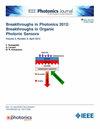基于微半球壳和光环谐振器的光机械陀螺仪
IF 2.1
4区 工程技术
Q3 ENGINEERING, ELECTRICAL & ELECTRONIC
引用次数: 0
摘要
硅光子集成电路和微机电系统有助于设计紧凑、高性能的微机电系统(MOEMS)陀螺仪,例如最近报道的光机械陀螺仪。然而,在真空环境下的密闭微/纳米系统内有效的片上光耦合对之前的光机械陀螺仪的常规角速度测量提出了挑战。此外,共振陀螺仪的一个核心挑战是直接测量共振频率位移,因此需要采用其他角速度检测技术。此外,这项研究还提出了一种新型光机械陀螺仪的设计方案,该陀螺仪基于与光学环腔谐振器集成在一起的微型半球壳谐振器。这种集成光机械装置结合了壳谐振器和光学环腔谐振器的原理,以提高陀螺仪的性能。通过片上硅波导的蒸发场耦合的高 Q 值光学环形谐振器是基本构件。总之,陀螺仪的设计利用了机械谐振器和集成光子学的原理,解决了下一代光机械惯性传感器在片上光耦合和角速度检测方面的难题。数值模拟表明,在输入激光功率为 5 mW、微半球壳质量为 212 ng 的条件下,光机械微半球壳谐振器陀螺仪的计算标度因数为 77.9 mV/(°/s),总角随机移动为 0.0662 °/h1/2。这些性能指标表明,拟议的集成光机陀螺仪设计有望用于需要芯片级惯性导航、姿态测量和稳定的应用。本文章由计算机程序翻译,如有差异,请以英文原文为准。
Optomechanical Gyroscope Based on Micro-Hemispherical Shell and Optical Ring Resonators
Silicon photonic integrated circuits and micro-electro-mechanical systems enable the design of compact, high-performance micro-opto-electro-mechanical systems (MOEMS) gyroscopes, such as recently reported optomechanical gyroscopes. However, effective on-chip light coupling within a confined micro/nano system under vacuum posed challenges for conventional angular velocity measurements in prior optomechanical gyroscopes. Additionally, A core challenge in resonant gyroscopes is directly measuring resonant frequency displacement, necessitating alternative angular velocity detection techniques. Alternatively, this work presents the design of a novel optomechanical gyroscope based on the micro-hemispherical shell resonator integrated with optical ring cavity resonators. This integrated optomechanical device combines the principles of shell resonators and optical ring cavity resonators to enhance gyroscope performance. The high-Q optical ring resonators coupled via evanescent fields from the on-chip silicon waveguide, serve as the basic building block. Overall, the gyroscope design utilizes principles of both mechanical resonators and integrated photonics to address challenges in on-chip light coupling and angular velocity detection for next-generation optomechanical inertial sensors. Numerical simulations demonstrated the optomechanical micro-hemispherical shell resonator gyroscope could attain a calculated scale factor of 77.9 mV/(°/s) and total angle random walk of 0.0662 °/h
1/2
for a micro-hemispherical shell mass of 212 ng at an input laser power of 5 mW. These performance metrics suggest the proposed integrated optomechanical gyroscope design holds promise for applications requiring chip-scale inertial navigation, attitude measurement, and stabilization.
求助全文
通过发布文献求助,成功后即可免费获取论文全文。
去求助
来源期刊

IEEE Photonics Journal
ENGINEERING, ELECTRICAL & ELECTRONIC-OPTICS
CiteScore
4.50
自引率
8.30%
发文量
489
审稿时长
1.4 months
期刊介绍:
Breakthroughs in the generation of light and in its control and utilization have given rise to the field of Photonics, a rapidly expanding area of science and technology with major technological and economic impact. Photonics integrates quantum electronics and optics to accelerate progress in the generation of novel photon sources and in their utilization in emerging applications at the micro and nano scales spanning from the far-infrared/THz to the x-ray region of the electromagnetic spectrum. IEEE Photonics Journal is an online-only journal dedicated to the rapid disclosure of top-quality peer-reviewed research at the forefront of all areas of photonics. Contributions addressing issues ranging from fundamental understanding to emerging technologies and applications are within the scope of the Journal. The Journal includes topics in: Photon sources from far infrared to X-rays, Photonics materials and engineered photonic structures, Integrated optics and optoelectronic, Ultrafast, attosecond, high field and short wavelength photonics, Biophotonics, including DNA photonics, Nanophotonics, Magnetophotonics, Fundamentals of light propagation and interaction; nonlinear effects, Optical data storage, Fiber optics and optical communications devices, systems, and technologies, Micro Opto Electro Mechanical Systems (MOEMS), Microwave photonics, Optical Sensors.
 求助内容:
求助内容: 应助结果提醒方式:
应助结果提醒方式:


